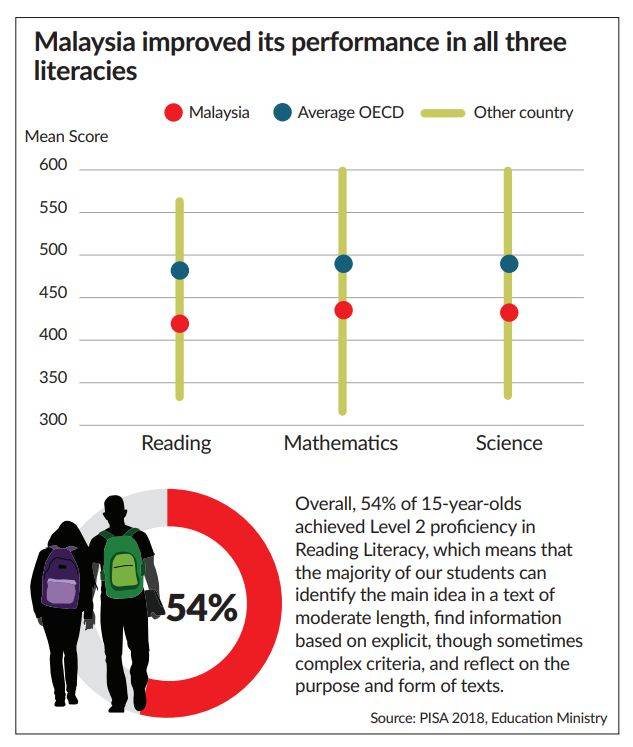MALAYSIA aims to rise above the global average and be in the top one-third of countries participating in the Programme for International Student Assessment (PISA), in line with the Malaysia Education Blueprint 2013-2025.
And, the recently released PISA 2018 results is proof that we’re on the right track.
Education director-general Datuk Dr Amin Senin is confident that the country would meet the target as we’ve just broken into the middle of the prestigious PISA ranking.
Malaysia improved significantly in all three PISA literacies despite a lower overall global average.
Improvements were especially significant in mathematics and science compared to 2009 and 2012.
Not only was Malaysia among only 12 out of 79 countries and economies that saw notably better performance in two of the three areas assessed, the number of high-achievers has increased, and there are less low achievers.
“Malaysia’s performance based on mean scores prove that the country’s education system is headed in the right direction as the results are nearing the Organisation for Economic Co-operation and Development (OECD) average.
“All our efforts including the implementation of HOTS (higher-order thinking skills), have led to this. The PISA results have shown marked improvements.
“We’ve moved up from the bottom 30% to the middle 30% of the ranking, performing better in all domains compared to other Asean countries, except Singapore, ” he said, when announcing the results in Putrajaya on Dec 3.
Singapore, alongside China (Beijing, Shanghai, Jiangzu and Zhejiang, and Macau) topped the assessment in all three domains.
The majority of PISA 2018 countries and economies, including Malaysia, achieved Level Two proficiency in the three literacy domains assessed, namely Reading, Mathematics and Science.
“We’re not just looking at achieving the OECD average. We’re aiming to be among the top 30% and I’m confident we can do it by the time the next two rounds of PISA assessments are done in 2024, ” said Amin.
Education Minister Dr Maszlee Malik said although the country’s performance has improved compared to 2012, and was ranked second among South East Asian countries, there was still much work to be done to ensure that our children are on par with the rest of the world.
The reality, he said, is that Malaysia was still at the bottom of the list when compared to the 11 developed countries assessed in PISA 2018.
“By facing up to the reality, we’re able to better plan for the improvement of our national education system. But we must be optimistic.
“We have only one goal – that is for our education system to produce students who can compete with the best in an ever-changing world.
“Please continue supporting and keeping abreast with the national education system because this is our joint responsibility.”
Mathematics
Malaysia’s performance greatly improved compared to 2009 and 2012. The country jumped by a whopping 36 points from 404 in 2009 to 440 last year. Among the high-achieving students, scores rose by 17 points for each PISA cycle despite 26 other countries recording lower mean scores compared to 2015.
Some 59% of students achieved Level Two proficiency and above in Mathematics. At Level 2, they can interpret and recognise, without direct instructions, how a situation – for example, comparing the total distance across two alternative routes or converting prices into a different currency – can be represented mathematically. The 2% at Level Five or higher could model complex situations mathematically, and can select, compare and evaluate appropriate problem-solving strategies for dealing with them.
Science
The country’s mean scores rose by 18 points from 420 in 2012, to 438 in the recent assessment. Of the countries and economies that participated, 42 experienced drops of between two and 22 points compared to 2015.
Some 63% of students could – at the minimum – recognise the correct explanation for familiar scientific phenomena and can use such knowledge to identify, in simple cases, whether a conclusion is valid based on the data provided.
Top performers, or 1% of the students, could creatively and autonomously apply their knowledge of and about science to a wide variety of situations, including unfamiliar ones.
Reading
In the past decade, Malaysia made significant progress in ensuring that all children reached minimum levels of proficiency in reading and mathematics by the end of lower secondary education.
Of the PISA 2018 nations and economies, 38 saw their scores fall between one and 18 points, but despite a drop in the OECD average, Malaysia achieved a mean score of 415, which was an increase of 17 points from the 2012 results.
More than half, or 54.2% of students achieved Level Two and above proficiency out of the nine levels identified. This means that the majority of our students can identify the main idea in a text of moderate length, find information based on explicit, though sometimes complex criteria, and reflect on the purpose and form of texts.
Students performing above minimum proficiency in reading grew by over 10 percentage points. They were, however, stronger in “locating information” than in “understanding”.
Some 10% of disadvantaged students scored in the top quarter of reading performance within Malaysia, indicating that disadvantage is not destiny.
Closing the gender gap
Although girls still outperformed boys, the gender gap between male and female students has narrowed in all three literacies. Although the difference in achievement was no longer significant in science and mathematics, there was still a significant gap of 26 score points in reading literacy.
While girls expressed greater fear of failure than boys, especially among top-performing students, 75% agreed that, when they fail, they worry about what others think of them.
Among high-performers in mathematics or science, two in five boys expect to work as an engineer or science professional, but only one in seven girls aim to do the same. More high-performing girls prefer health-related professions compared to the boys. Some 2% of boys and 1% of girls expect to work in ICT-related professions.
Passionate teachers
About 84% of students agreed that teachers enjoyed their work, were diligent and interested in the subjects they taught. The same number of students also said that their teachers gave extra guidance to those who needed it and would make sure that the class understood the lesson. Students scored higher in reading when they perceived their teacher as more enthusiastic.
Reading habits
Unlike in 2009, last year’s assessment found that reading was no longer a hobby for students. They only read when they were forced to or when they had to do it for a specific purpose.
Newspapers, which even though showed the biggest decrease as being read since 2009, remain the most popular reading material, followed by fiction and comics.
The percentage of students who go online to look for information was almost as high as the OECD average. Over 80% went online to learn about a topic, gain practical knowledge and read the news.
Well-being
Some 94% of students said they were sometimes or always happy; 63% were satisfied with their lives; and 41% have a growth mindset. It’s heartening to note that 80% said they could usually find a way out of difficult situations.
While 36% reported being bullied at least a few times a month, 87% agreed that it was a good thing to help students who could not defend themselves.
In Malaysia, 81% said their schoolmates co-operated with each other, while 72% reported that they competed with each other.
About PISA
PISA is administered by the Organisation for Economic Co-operation and Development (OECD) every three years on 15-year-olds in both OECD and non-OECD countries and offers students questions in the main language of instruction in their respective countries.
Each round focuses on either reading, mathematics or science. The main domain in 2018 was reading.
Some 600,000 students completed the assessment last year, representing about 32 million 15-year-olds in 79 participating countries and economies.
The assessments have been conducted since 2000 but Malaysia’s participation only started in 2009. A total of 6,111 students from 191 Malaysian schools were assessed in 2018.
A list of students from national secondary schools, national religious schools (SMKA), fully residential schools (SBP), Mara Junior Science College (MRSM), Government-Assisted Religious Schools (SABK), religious state secondary schools, private schools, international schools and Chinese independent secondary schools (SMPC) were presented to the OECD for their sample selection.
As Malaysia met all OECD operational standards and guidelines, its results could be compared with those of other participating PISA 2018 nations and economies.
PISA results are used to help the Education Ministry improve text books, 21st century learning, ICT literacy, teacher development, evaluation and assessment, teaching and learning methods, the national curriculum and HOTS.








